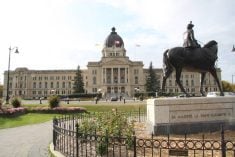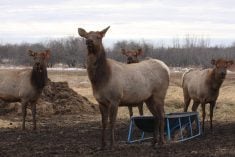Buyers from across North America are expected to attend Elk Island National Park’s first wood bison auction, said park warden Wes Olson.
“It’s probably going to be a very heavily attended auction,” said Olson, who estimated 30 to 50 animals will be up for sale at the park located east of Edmonton.
The park, which devotes about 60 sq. kilometres to its wood bison, tries to keep the population at 400 and most years surplus animals go to other free-roaming herds.
However, this year Elk Island can’t find park homes for all of the extra bison. So after the animals are given disease and pregnancy tests some will go to the auction block.
Read Also

Why feds imposed EV tariffs
Moe and Kinew have a fight on their hands when it comes to eliminating the EV tariff. Canada has to worry about pissing off the U.S. and Mexico and hundreds of thousands of auto workers.
Seven bred cows, plus bulls ranging from calves to four year olds, are expected to average $5,000 each, said Olson. The money will either go to refurbish the park or to help establish new national parks in northern Canada.
“I’m excited about the sale. I just have to go see my banker now,” said Fred Hoeber, who has a bison and elk ranch near Riviere Qui Barre, Alta.
Looking for bulls
He has 20 purebred wood bison heifer calves that are less than a year old and wants to find yearling bulls.
“The nice thing about this sale is you know it’s all going to be pure wood bison,” said Hoeber, who notes the breed draws more than its plains bison counterpart because the animals are normally about 25 percent heavier and more rare.
Typically wood bull calves range from $5,000 to $10,000, while plains bull calves start at about $1,200, said Hoeber.
He hopes to have wood bison for sale if and when the United States takes them off its endangered species list. While some American producers might attend the park sale, it is now illegal to import wood bison in the U.S.
Wood bulls are still on Canada’s threatened wildlife list after being removed from the endangered list 10 years ago.
The park’s first priority is to build wild herds when possible, said Wilson, noting the goal is to have four free-roaming herds of 400 wood bison across Canada.
There is now one herd at 400, another at almost 400 and two in the 200 range. It will likely take about a decade to reach the population goal, said Olson.
The park keeps its plains bison herd at around 600 and plans to auction off more than 120 of those animals this year.
One of producers’ main concerns when buying wild bison is to ensure the animals are tuberculosis and brucellosis free, said Fiona Williams of the Alberta Bison Association. The diseases can cause problems with fertility and spontaneous abortions.
No disease
Bison at Elk Island National Park are disease free when they leave the park, said Olson, who noted the park hasn’t had outbreaks of any major diseases since 1971.
Wood bison were originally brought into the park in 1965 and the herd grew to 400 from 23. They are all descendants of the original animals.
Once producers take the reserve bison home they should integrate well with their ranch herd, said Williams.
“They’re very much a herd animal and they like to stay together. Like any new entity into an existing entity, they just have to arrange their new pecking order.”














